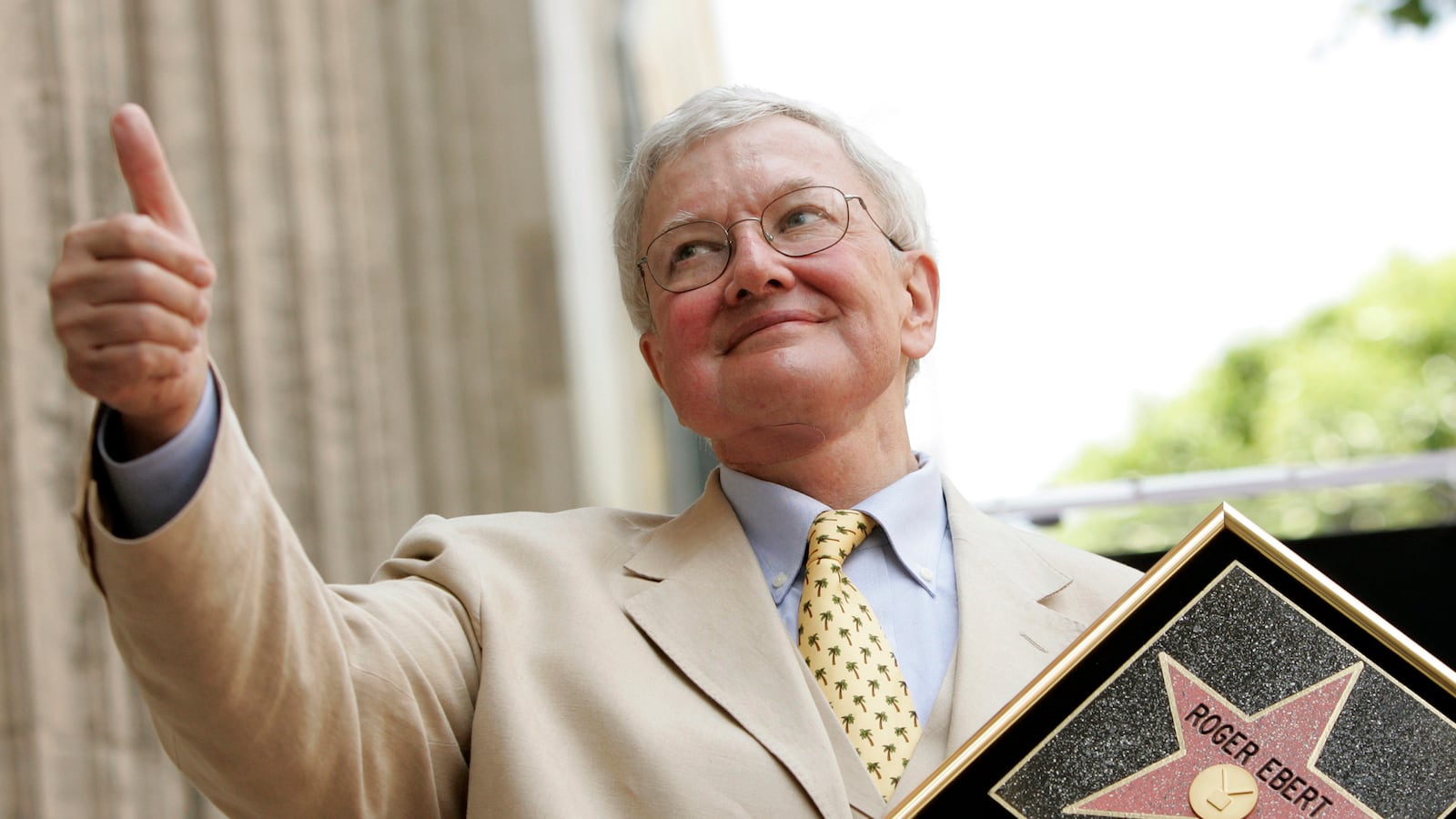Roger Ebert took convincing.

It was the spring of 2012 when Steve James, the documentary filmmaker behind Hoop Dreams and The Interrupters, was approached by Steven Zaillian, the Oscar-winning writer of Schindler’s List, and his producing partner Garrett Basch, to adapt Ebert’s bestselling memoir Life Itself. Though they weren’t pals, James was friendly with the fellow Chicagoan, having first crossed paths at the 1993 Toronto Film Festival where he’d brought his aforementioned basketball doc (Ebert would later rank it the best film of the ’90s). By James’ estimation, they’d met “less than 10 times since.”
Nevertheless, James loved the idea. “He is a significant film critic, but it’s his life that makes it an amazing story,” James tells me at the Nantucket Film Festival.
He digested the memoir in a single day. Told with Ebert’s trademark introspection, it traced the affable curmudgeon’s life story from his early newspaper days as a randy boozehound to his rise up the film critics’ ranks to the thyroid cancer that claimed his lower jaw and stripped the wordsmith of the ability to speak. It was a cinematic tale, to say the least. But first, James had to gain his would-be subject’s approval.
“From my first email exchange with him, he wasn’t convinced that he warranted a documentary,” says James. “He thought, Really? A documentary on a film critic?”
James wasn’t alone. There were, by his guess, “several other people circling Roger” with the idea of adapting his memoir into a documentary film. Thus began a flurry of back-and-forth emails between director and subject.
“The gist of my pitch was: I loved your memoir, and I love the way you look back on your life through this prism of your life now,” says James. “You’re looking back on your life from the perspective of someone who can’t eat, can’t speak, and has been compromised in some ways—though not intellectually, or creatively. I want to follow you around in the present, to get a window into your present life and how you go about it, despite all that you’ve been through, and then use that at a springboard to the past.”
Ebert gave James the proverbial two thumbs up, and the project was a go. Then came the issue of financing. Despite the “amazing story,” all the major TV networks stonewalled the filmmaker, including HBO. “I got the same response: He’s Roger Ebert, but he’s just a film critic. I was shocked. I thought this would have been one of the easiest films to fundraise for, and it wasn’t.”
James had to hustle for every penny, first receiving seed money from a group of “venture philanthropists,” including Michael Ferro, the owner of the Chicago Sun-Times. It wasn’t enough to finish the film—that was accomplished later thanks to an Indiegogo crowdfunding campaign that raised $160,000— but gave his team the green light to begin filming, which commenced in December 2012.
Life Itself, in theaters July 4, opens with Ebert in the hospital, hammering away on a film review. In his heyday, he’d churn out about 200 reviews a year for the Sun-Times, which were syndicated nationwide. Despite the loss of his jaw, voice, and ability to eat—in one heartbreaking scene, we witness a nurse draining his throat by suction via a tube in his neck—Ebert’s final year was his most prolific as a critic, amassing, he says, “306 movie reviews, a blog post or two a week, and assorted other articles.” There’s a spark in his eye, and he feels, despite his compromised physical state, brimming with life.
The film then flashes back to Roger’s upbringing, an only child born to an electrician and a bookkeeper in Urbana, Illinois. He was, until his dying day, a social progressive, even penning a piece for his college paper in which he quoted Martin Luther King Jr. at the height of the Civil Rights Movement. He got a job out of college at the Sun-Times and, when the paper’s critic left in 1967, was randomly tapped for the job.

There are many surprises from his early days at the Sun-Times, including Ebert’s holding court at O’Rourke’s, a local pub, where he’d regale his coworkers with tall tales. In the film, his pals fondly recall the critic bringing through a carousel of unattractive women. Around this time, Ebert was tapped by Russ Meyer to pen the screenplay to the 1970 erotic-schlock flick Beyond the Valley of the Dolls presumably, says one of his pals, because “he was a fan of boobs.” The film also addresses Ebert’s long, hard battle with alcoholism—which he kicked in 1979.
It then explores Ebert’s love of and marriage to his African-American wife, Chaz, as well as his contentious relationship with his rival-turned-sidekick, Gene Siskel. The two couldn’t have been further opposites, with the studious Ebert lording his Pulitzer over Siskel, and the more telegenic, charming Siskel constantly pushing his buttons. Siskel’s wife, Marlene, recalls Ebert stealing a cab from her when she was eight months pregnant, while Ebert’s pals share stories of Siskel reading Ebert’s date book and then scooping him on stories. They were the Playboy and the Plato, but together, they brought film criticism to the mainstream with their TV show At the Movies (later Siskel & Ebert), giving deserving films that coveted two thumbs up.
“They clearly didn’t like each other for a long time, and didn’t really socialize,” says James. “This isn’t in the film, but Gene’s wife told me that, for all the years that they were together, she never had a social dinner with Roger, Chaz, and Gene. That tells you something.”
Still, the program, along with his many books on film, elevated Ebert to “rock star status,” says James. “In some ways, he was more famous than many of the films he was covering,” adds New York Times critic A.O. Scott in the film.
These flashbacks in Life Itself appear to be narrated by Ebert’s voice, but it actually comes courtesy of Stephen Stanton, an acclaimed “audio double” who’s served as the voice-match for actors ranging from Sir Alec Guinness to Robert Downey Jr.
James got several filmmakers—and pals of Ebert—to pay their respects in the film, including Errol Morris, Werner Herzog, Ramin Bahraini, Gregory Nava, and of course, Martin Scorsese, who also served as an executive producer on the film.
And it’s Scorsese, a close friend of Ebert’s, who provides the most touching A-list anecdote. Scorsese recalls carrying around Ebert’s glowing review of his debut feature, Who’s That Knocking at My Door, in his jacket pocket for a whole year after it was published. Ebert wrote that the film announces “the arrival of an important new director.” Later, in 1980, Ebert and Siskel invited Scorsese to the Toronto Film Festival, where they were to honor him with a career tribute. Scorsese says he was struggling with an awful drug addiction at the time and was suicidal, but that the invite helped save his life.
“People have told me, I haven’t seen that side of Marty—ever,” says James. “And in all the writing on Marty I’ve read, I’ve never heard that story.”
About a month-and-a-half into filming, in January 2013, James got a bad feeling.
“I knew something was up because I’d be there filming, a doctor would come in, and Chaz would say, Would you please leave the room?” says James.
Ebert’s cancer had spread, and he was given just a few months to live. In one poignant scene, just after the news of the diagnosis, the impossibly strong Chaz breaks down, addressing the camera and requesting that they stop filming.
“We had three people in our crew—myself, producer Zak Piper, and our DP, Dana Kupper,” says James. “They were feeling very vulnerable, so I shot that portion by myself. Chaz told me not to tell the crew about the diagnosis, so it was weird for a while, but I really tried to honor that for as long as I could.”
With Ebert’s health in decline, James drafted “nine pages of single-spaced questions, 12.5 font” for Ebert to answer via email. “I’d say he got through a page and a half,” says James.
“Down towards the end I was talking to Chaz and she said, ‘His spirits are so low, I feel like he’s giving up,’” recalls James. “So I said, ‘Why don’t I send him some fun clips from some of the interviews?’ I sent him some clips, including the clip where his pal says, Fuck Pauline Kael. She said it raised his spirits.”
But then it happened. On April 4, 2013, just two days after announcing his retirement from film criticism—which he dubbed “A Leave of Presence,” in perhaps his most moving essay—Ebert passed away.
“We were about four months in when he passed,” says James. “He was clearly declining, but only in retrospect does it look like of course, he’s dying. Chaz had instilled a will in him to live before and brought him back from the brink numerous times. She was confident that he was going to do it again, and who am I to doubt Chaz?”
James takes a long pause. “Two hours before he died, I was texting back-and-forth with Chaz. We’d planned to shoot Roger leaving rehab and going to hospice care, and Chaz believed that he was going to get away from the hospital, feel better, and come out of hospice care. I was standing by to go film him leaving and listening to the local NPR station and the host said, ‘We just got word that Roger Ebert has died.’ I thought, This can’t be true. I’m supposed to go film him. I thought it was a hoax. And then I got a text from Chaz saying, ‘Please come down to the rehab institute. Roger has passed away.’”
Though he left us far too soon, Ebert leaves behind a rich legacy. According to James, cinema’s great appreciator is in many ways responsible for online film criticism’s very existence.
“I just learned this the other day from Chaz,” says James. “Some years back, the studios wanted to bar Internet critics from screenings because they didn’t think they were ‘real’ critics, but Roger met with the studios and said, ‘You’ve got to let these people in.’ He made it happen.”
And so while his writing wasn’t as heady and challenging as Pauline Kael’s, Roger Ebert will undoubtedly go down as the most popular film critic ever; the People’s Critic, so to speak.
“He took what’s been called the most democratic art form—film—and crafted the most democratic form of film criticism about it,” says James. “His reviews could be appreciated by casual moviegoers who just wanted to find out what to see, but also people with a deeper understanding of cinema. He somehow managed to put himself in his reviews without it ever feeling vain. He humanized film criticism.”






